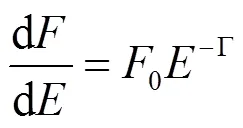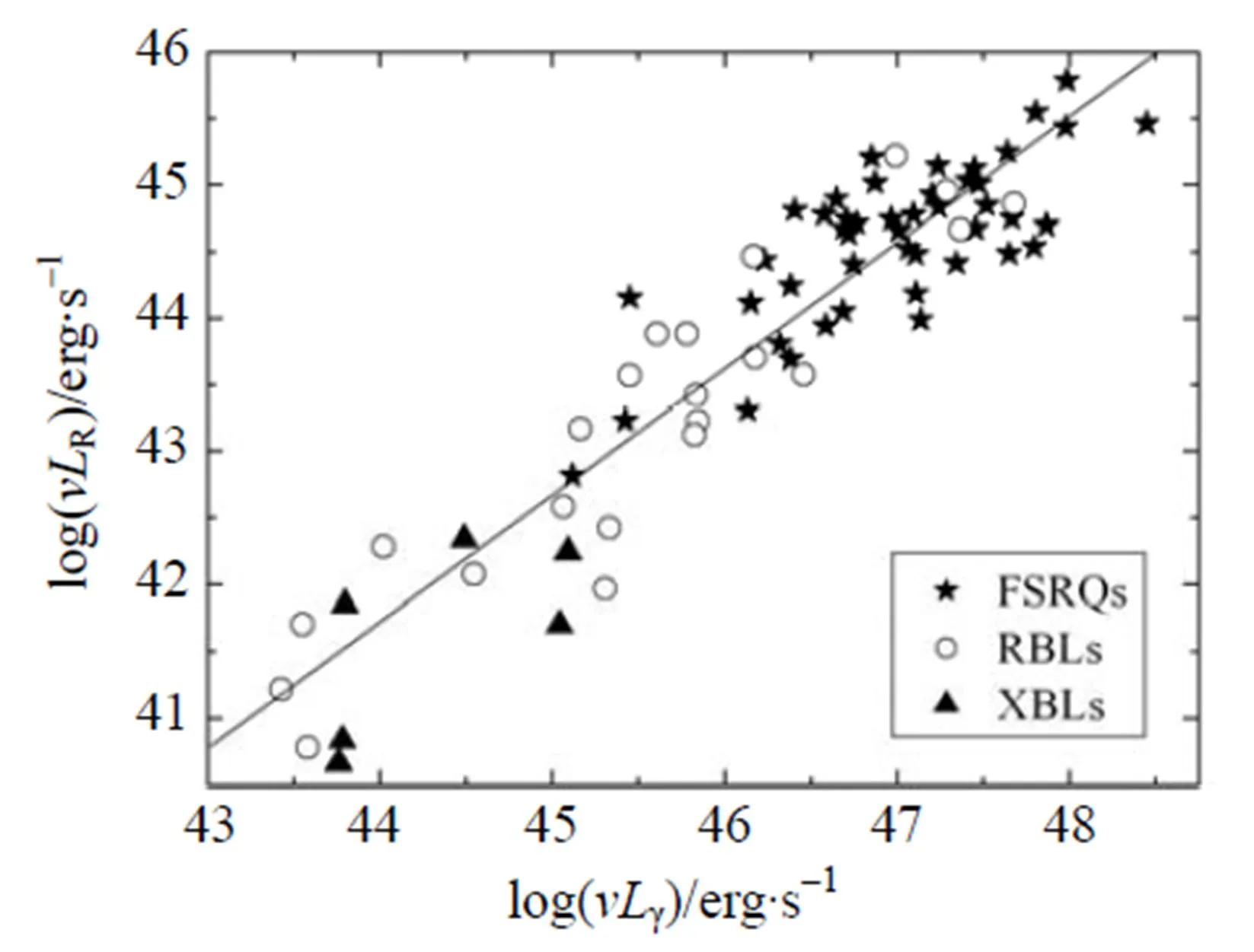The γ-ray and radio emissions of blazars observed by Fermi Gamma Ray Space Telescopein the first three months
2011-05-10NIEJianjunYANGJianghe
NIE Jian-jun, YANG Jiang-he
The γ-ray and radio emissions of blazars observed by Fermi Gamma Ray Space Telescopein the first three months
NIE Jian-jun, YANG Jiang-he
(Department of Physics and Electronics Science, Hunan University of Arts and Science, Changde 415000, China)
In this work, the radio and γ-ray emissions are compiled for a sample of 74 γ-ray loud blazars (46 flat spectrum radio quasars, 28 BL Lac objects) to calculate the radio - γ-ray effective spectrum indexRγ. Also the correlations betweenRγand γ-ray luminosity, and radio and γ-ray luminosity are investigated. Results are as follows: For radio and γ-ray luminosity, there is a consequence for FSRQs, RBLs, and XBLs. RBLs seem the bridge connect FSRQs to XBLs. A strong correlation between radio and γ-ray luminosity is found, with a correlation coefficient of= 0.93, and a chance probability< 0.000 1. It supports that the γ-ray is associated well with the radio emissions, and the γ-ray emissions likely from the SSC process. We also found that FSRQs and BL Lacs can be divided partially at log(γ) = 46 erg×s-1in the plan of radio to γ-ray effective spectrum index vs γ-ray lominosity.
Active galactic nuclei (AGNs); BL Lacs; Quasars; γ-ray emissions
The Fermi Gamma Ray Space Telescope began on 11 August, 2008. The sensitivity of the Large Area Telescope (LAT) on Fermi is increased more than an order-of-magnitude over its predecessor EGRET. One of the major scientific goals of the Fermi Gamma Ray Space Telescope is to provide new data about γ-ray activity of AGNs[1]. In the first three months of operation, the Fermi Gamma Ray Space Telescope revealed more than one hundred blazars. There are 104 blazars consisting of 57 flat spectrum radio quasars (FSRQs), 42 BL Lac objects, and 5 blazars with uncertain classification. In the Fermisample, the correlations between their γ-ray and radio fluxes/luminosities and between the photon spectral indexγin the Fermi energy band and their radio luminosity are found[2].
Blazars are extremely active galactic nuclei (AGNs) showing rapid and large variation, high and variable polarization, superluminal motion and high energetic γ-ray emissions[3]. Blazars consists of two different subclasses as BL Lacertae objects (BL Lacs) and flat spectrum radio quasars (FSRQs) in the case of emission lines. BL Lacscan be divided further into RBLs and XBLs. The classification is based on the survey result, has no physics, but the distinction of XBLs and RBLs is clear, which was explained based on the relativistic beaming model[4-7].BL Lacs have no or very weak emission line while FSRQs have strong emission lines. Both BL Lacs and FSRQs are strong γ-ray emitters (~TeV Blazar), and their emission mechanisms are investigatedcontinuous by many authors[8-11]. Some γ-ray blazars are also superluminal radio sources. Both subclasses have no evolution effect, the emission lines difference is from the fact that the ratio of the de-beamed emissions to the unbeamed emissions in the co-moving frame is not the same. The ratio in BL Lacs is larger than that in FSRQs, this difference results in the observation difference in emission lines between BL Lacs and FSRQs[12]. The relationship between BL Lacs and FSRQs is not very clear yet.
In this letter, we will use the Fermisample[1]to calculate the radio to γ-ray effective spectrum index, and investigate the correlation between the effective spectrum index and γ-ray luminosity for FSRQs, RBLs and XBLs. In the 2nd section the new data of the sample are given. The calculation method and results are given in the 3th section. In the 4th section, we give some discussions and a brief conclusion.
1 Sample
LAT Bright AGN Sample (LBAS)[1]contains 2 radio galaxies, 104 blazars (57 FSRQs, 42 BL Lacs, and 5 uncertain classification blazars), 4 new blazars. There are 10 BL Lacs with not redshift. So, 89 blazars of these are usable. We find 74 sources of the 89 blazars with radio 5 GHz flux from the available literatures. It contains 46 FSRQs and 28 BL Lacs consisting of 22 RBLs and 6 XBLs (see Table 1).
The descriptions of the columns in Table 1 are as follows:
Col. (1) LAT name of the sources; Col. (2) other name; Col. (3) redshift; Col. (4) classification; Col. (5) the γ-ray photon spectral index and uncertainty[1]; Col. (6) the γ-ray photon flux (100 MeV) and uncertainty in units of 10-8photon·cm-2·s-1[1]; Col. (7) the radio flux at 5 GHz in units of Jy; Col. (8) the references for the radio flux, Col. (9) the luminosity distance calculated by Eq.(6).

Table 1 Sample of blazars
Note for References in table 1: †—Reference [1];D01—Reference [13]; NED—Reference [14]; M01—Reference [15]; B94—Reference [16]; K81—Reference [17].
2 Method and Results
2.1 Calculation Method
We converted the γ-ray photon fluxes, namely100(> 100 MeV, photon·cm-2·s-1) in Table 1, to γ-ray flux densities at 1 GeV. Because,

So,

Therefore,

The γ-ray fluxes F1 GeVare k-corrected according to
. (4)
The luminosities for radio 5 GHz and γ-ray emission at 1 GeV are calculated by Eq.(5).

whereLis the luminosity distancecomputed by following formula[18].

We adopt a cosmologywith0=73.00 km·s-1·Mpc-1, Ωm= 0.27, and Ωv= 0.73.
We calculate the radio 5 GHz to γ-ray emission at 1 GeV effective spectrum index values,Rγ, using Eq.(7).

2.2 Results
Using the data in Table 1 and considering Eqs. (1)—(7), we can get radio to γ-ray effective spectrum indices (Rγ), and the γ-ray luminosities for all sources listed in table 1. The calculation results are as follows.
For FSRQs:
For RBLs:
For XBLs:
The plans of log(γ) vsRγ, and log(γ) vs log(R) are shown in Fig. 1 and Fig. 2 respectively. We perform the linear regression analysis for the radio and the γ-ray luminosities. We have log(R) = (0.94 ± 0.04) log(γ) + (0.24 ± 2.06), with a correlation coefficient of= 0.93, and a chance probability< 10-4.

Fig.1 Plan of the effective spectrum index vs γ-ray luminosity.

Fig.2 The correlation between radio and γ-ray luminosity.
3 Discussion and conclusions

In Fig.1, the symbols of pentagram, circle and triangle correspond to FSRQs, RBLs and XBLs, respectively. Apparently, those symbols occupy different areas in theRγ- log(γ) plan. i.e. where BL Lacs and FSRQs occupy different regions.FSRQs and BL Lacs consisting of RBLs and XBLs can be divided partially by the line at log(γ) = 46 erg×s-1in Fig.1. Most sources of the BL Lacs occupy left area, and most FSRQs in the right area. There only 3 FSRQs and 7 BL Lacs are unsuitable. By LAT name, they are J1229.1 + 0202, J1355.0-1044, J2143.2 + 1741 for FSRQs, and J1802.2 + 7827, J0818.3 + 4222, J0222.6 + 4302, J0334.1-4006, J0538.8-4403, J0428.7-3755, J0238.6 + 1636 for BL Lacs.
From above analysis, we consider that the RBLs is the bridge connect XBLs to FSRQs, and RBLs is the middle state of FSRQs and XBLs. Ghisellini et al.[2]suggest that this division has its origin in the different accretion regimes of the two classes of objects. The spectral separation in hard (BL Lacs) and soft (FSRQs) objects can then result from the different radiative cooling suffered by the relativistic electrons in jets propagating in different ambients.
Blazars consist of two subclasses with quite different emission line features (BL Lacs and FSRQs). Their relationship is still an open question. The γ-ray emission mechanisms are also not quite clear. For the discussion of the γ-ray emissions, many authors have studied the correlation between the γ-rays and the low-energy waveband emissions, particularly between the γ-rays and the radio emissions.Zhou et a1.[19]found that the γ-ray emission is a correlated with the radio core emissions. Fan et a1.[20]found that, for the maximum data, the γ-ray emission is more closely correlated with the high frequency(1.3 mm, 230 GHz) radio emission than with the lower frequency (5 GHz, 6 cm) radio emission. Schachter and Elvis[21]reported that there is a correlation between the γ-ray and 5 GHz radio emissions. A good correlation between the radio and γ-ray luminosities for the γ-ray-loud blazars was found by Dondi and Ghisellini[22]. Mao et al.[23]and Yang et al.[24]investigated in detail the relation between radio and γ-ray emission flux density, and the similar results were obtained.

In this paper, we collected a sample of 74 blazars (46 FSRQs, 28 BL Lacs) depend uponblazars, calculated the radio to γ-ray effective spectrum indices, and discussed the correlation between the effective spectrum indices and γ-ray luminosity. We found that, for radio and γ-ray luminosity, there was a consequence for FSRQ, RBL, and XBL. FSRQ and XBL are different with RBL be the bridge connect FSRQ to XBL. A strong correlation between radio and γ-ray luminosity is found. It support that the γ-ray are associated well with the radio emission, and the γ-ray emission likely from the SSC process. We also found that FSRQs and BL Lacs can be divided partially at log(γ) = 46 erg×s-1in the plan of radio to γ-ray effective spectrum index vs γ-ray luminosity.
[1] Abdo A A, Ackermann M, Ajello M, et al. Bright AGN Source List from the First Three Months of the Fermi Large Area Telescope All-Sky Survey[J]. ApJ, 2009, 700: 597-622.
[2] Ghisellini G, Maraschi L, Tavecchio F. The Fermi blazars' divide[J]. MNRAS, 2009, 396(1): 105-109.
[3] Urry C M, Padovani Paolo. Unified Schemes for Radio-Loud Active Galactic Nuclei[J]. PASP, 1995, 107: 803-845.
[4] Fan J H, Xie G Z, Li J J, et al. Radio-selected BL Lacertae objects and some correlations[J]. ApJ, 1993, 415: 113-117.
[5] Fan J H, Huang Z H, Li J J, et al. BL LAC objects and acceleration model[J]. Ap&SS, 1994, 213: 305-309.
[6] Fan J H, Xie G Z. The properties of BL Lacertae objects[J]. A&A, 1996, 306: 55-60.
[7] Fan J H. Gamma-ray emission of blazers[J]. Ap&SS, 1997, 246: 119-128.
[8] Ghisellini G, Tavecchio F, Bodo G, et al. TeV variability in blazars: how fast can it be? [J]. MNRAS, 2009, 393: 16-20.
[9] Dermer Charles D, Finke Justin D, Krug Hannah, et al. Gamma-Ray Studies of Blazars: Synchro-Compton Analysis of Flat Spectrum Radio Quasars[J]. ApJ, 2009, 692(1): 32-46.
[10] Graff Philip B, Georganopoulos Markos, Perlman Eric S, et al. A Multizone Model for Simulating the High-Energy Variability of TeV Blazars[J]. ApJ, 2008, 689(1): 68-78.
[11] Böttcher Markus, Dermer charles D, Finke Justin D. The Hard VHE γ-Ray Emission in High-Redshift TeV Blazars: Comptonization of Cosmic Microwave Background Radiation in an Extended Jet? [J]. ApJ, 2008, 679(1): 9-12.
[12] Fan J H. Relation between BL Lacertae Objects and Flat-Spectrum Radio Quasars [J]. ApJ, 2003, 585: 23-24.
[13] Donato D, Ghisellini G, Tagliaferri G, et al. Hard X-ray properties of blazers[J]. A&A, 2001, 375: 739-751
[14] NED--NASA/IPAC EXTRAGALACTIC DATABASE, http://nedwww.ipac.caltech.edu/
[15] Mattox J R, Hartman R C, Reimer O. A Quantitative Evaluation of Potential Radio Identifications for 3EG EGRET Sources [J]. ApJSS, 2001, 135: 155-175.
[16] Brinkmann W, Siebert J. Spectral properties of X-ray loud extragalactic radio sources [J]. A&A, 1994, 285: 812-818.
[17] Kühr H, Witzel A, Pauliny-Toth I I K, et al. A catalogue of extragalactic radio sources having flux densities greater than 1 Jy at 5 GHz[J]. A&ASS, 1981, 45: 367 - 430.
[18] Pedro R. C, Priyamvada N.How robust are the constraints on cosmology and galaxy evolution from the lens-redshift test?[J]. NJPh, 2007, 9(12): 445-474.
[19] Zhou Y Y, Lu Y J, Wang T G, et al. Correlation Between VLBI Radio Flux and Gamma-Ray Flux of EGRET Active Galactic Nuclei [J]. ApJ, 1997, 484: L47-L50.
[20] Fan J H, Adam G, Xie G Z, et al. Correlation between the gamma -ray and the radio emissions[J]. A&A, 1998, 338, 27-30.
[21] Schachter J, Elvis M. Gamma-ray bright quasars and BL Lacertae objects: EGRET data[J]. ApJS, 1993, 92: 623-625.
[22] Dondi L, Ghlselhni G. Gamma-ray-loud blazars and beaming [J]. MNRAS, 1995, 273: 583-595.
[23] Mao Li-Sheng, Xie Guang-Zhong, Bai Jin-Ming, et al. Statistical Properties of a Blazar Sample and Comparison of HBLs, LBLs and FSRQs[J]. ChJAA, 2005, 5(5): 471- 486.
[24] Yang Jiang-He, Fan Jun-Hui. The Correlation between Gamma-ray and Radio Emissions in γ-ray Loud Blazars [J]. ChJAA, 2005, 5: 229-237.
费米伽玛射线空间望远镜最初3个月观测Blazar的射电和伽玛射线辐射研究
聂建军, 杨江河
(湖南文理学院 物理与电子科学学院, 湖南 常德, 415000)
以费米伽玛射线空间望远镜运行来最初3个月观测的Blazar为样本, 给出了74个(46个平谱射电类星体, 28个BL Lac天体)伽玛射线噪Blazar天体的射电(5 GHz)和伽玛射线流量, 计算了射电到伽玛射线辐射的有效谱指数Rγ. 研究了有效谱指数及射电光度与伽玛射线光度的关系.结果表明: 对于射电和伽玛射线光度都有一个相同序列, 即: FSRQs、RBLs、XBLs, RBLs似乎为FSRQs和RBLs的中间状态. 发现射电和伽玛射线光度强线性相关, 相关系数= 0.93, 或然概率< 0.000 1. 表明伽玛射线辐射和射电辐射有很好地关联, 伽玛射线辐射应来自同步自康普顿辐射. 我们还发现, 在Rγ对γ图中, 能用直线log(γ) = 46 erg×s-1较好地将FSRQs和BL Lacs分离.
活动星系核; 蝎虎天体; 类星体; 伽玛射线辐射
10.3969/j.issn.1672-6146.2011.03.009
P 157
1672-6146(2011)03-0027-06
2011-9-23
湖南省自然科学基金(10JJ3020); 湖南省“十一五”重点建设学科——光学基金资助
聂建军(1970-), 男, 讲师, 研究方向为恒星星系. E-mail:
(责任编校:刘刚毅)
